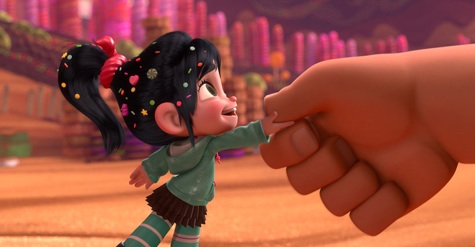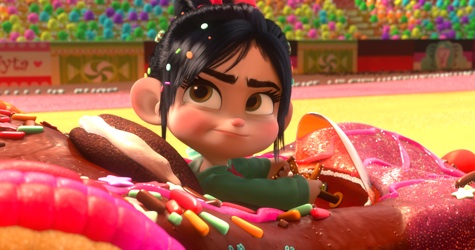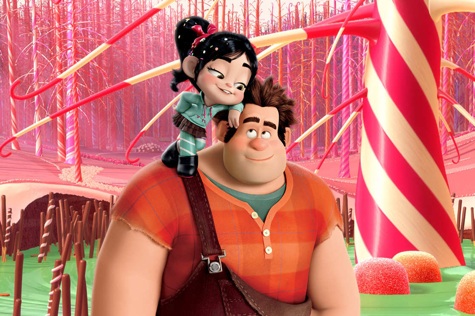It was pointed out that when the trailers for Wreck-It Ralph first emerged, it looked more like a Pixar film than your average Disney jaunt. Since the companies are technically all under the same roof, the point might be moot, but that made me wonder if Ralph shouldn’t be up for the same treatment that any other Disney animated feature might earn. And that got me thinking about Wreck-It Ralph’s unlikely hero, Vanellope von Schweetz, the glitch with enough guts to alter her reality for the better.
(MAJOR SPOILERS for Wreck-It Ralph ahead.)
I have to give the editor of the movie’s trailer credit; from the way it was pieced together, the bulk of Wreck-It Ralph’s story was very well-hidden, and Vanellope’s character seemed likely to be a minor pitstop on Ralph’s journey. Yet it really could be argued that Vanellope is the movie’s central figure, or at the very least that Ralph’s endgame is only possible because of his commitment to Vanellope’s journey.
We sympathize with Ralph from the beginning as audience members; he’s got a rotten deal, brought about by nothing he can control. He’s basically a sweet guy with a big temper, which you can’t blame him for when you take a look at how the nasty denizens of “Niceland” treat him on a day to day basis. It’s not his fault they never bother to consider that what he has to do “in game” might be different from who he is as a person.
Meeting Vanellope is different—she starts out vaguely annoying, playing the part of a clever trip-up on the road through Wonderland (I find the Wonderland metaphor particularly apt since Alan Tudyk’s voice for King Candy is a dead ringer for Disney’s Mad Hatter in their Alice cartoon feature). It’s not long before we find out that she has a reason for postponing Ralph’s chances at Instant Heroism. She wants to race for a chance to be added to the board of avatars in her game, Sugar Rush. There’s only one problem; Vanellope is a “glitch,” tending to go all pixeled, blinking in and out for split seconds at a time. The other racers make fun of her and destroy her first car, earning her Ralph’s help and a tentative alliance.

From there, the film makes some fascinating choices. We can see a similarity between Ralph and Vanellope’s duo and perhaps Sully and Boo from Monsters, Inc.—big tough guy and the cute little girl who melts his heart and becomes his best friend—but Vanellope is capable of action in a way that Boo never was because she’s not an actual toddler. In addition, Vanellope is the only one to prove to Ralph that he has creative impulses alongside his destructive ones when she immediately fawns over the car he designs for her. She enjoys it because it isn’t a slick, fancy number like the other girls have, teaching him that sometimes the act of creation is allowed to be messy and chaotic, that beauty isn’t about perfection.
Vanellope is at a disadvantage in her world, or so she’s led to believe. Glitches can’t leave their games, so she’s barred from a life interacting with others outside her home, where she might have made friends and felt like she belonged more. When the other racers tease her for glitching, Vanellope responds, “I’m pix-lexic,” a clear play on dyslexia. The subtle likening of Vanellope’s difficulties to a learning disability is probably intentional—but at the end of the story, Vanellope is proud that she can glitch, and has no intention of giving it up. Of course, no one would make the claim that having a disability is a treat or incredibly useful, but Vanellope’s acceptance of the glitch does send a good message to any children with disabilities who might be watching the film; that it is a part of who they are, and embracing every part of yourself can lead to greatness.
And Vanellope is all about embracing. In juxtaposition to Ralph, who needs time to learn what he has to offer the world and spends a large portion of the movie trying to decide what the right path is, his pint-sized racing pal never wavers from her own road. She knows she’s born to race, that she belongs on the track. And that self-assuredness is bourn out when we find that Vanellope was originally Sugar Rush’s princess, usurped when King Candy locked up the memories of every character in the game and destroyed her code. After she is restored to her rightful uniform, bedecked in pastel floofery, she immediately changes back to her old duds—a funny green hoodie sowed up with pink yarn and some mismatched candy in her hair. She doesn’t want any part of that pomp. She wants to be president! She wants to leave off hoop skirts! She wants to get back on the track and shift gears!

Vanellope embodies the sort of qualities that Disney princesses consistently extoll—ingenuity, compassion, determination—but also has realistic faults that make her easier for young girls to identify with. In addition, it would be nice to see the princess pantheon embrace a character who wasn’t nearly or practically an adult; boys get characters like Peter Pan and Stitch and little Simba, but every Disney princess is 16 years or older (and usually about to get married to the man of her dreams), which has always been sort of silly, especially when you remember that they are the character set that Disney consistently markets to girls above all others.
So it would be nice to see Vanellope wedged between Sleeping Beauty and Mulan. (Heck, she and Mulan would probably get along famously.) And while I’m not holding my breath for Disney to update their marketing any time soon, I suppose I can just imagine her there in my mind’s eye. Princess (or President) race car drivers will always get center stage in my book.
Emmet Asher-Perrin admits the end of the movie got her right in the feels. You can bug her on Twitter and read more of her work here and elsewhere.











I wholeheartedly agree. My 6 year old daughter loves Vanellope and hasn’t stopped talking about her in weeks. She asks me constantly to tell her stories about Vanellope.
I loved this movie. Vanellope was annoying, but very likable. I could really relate to her and Ralph from the way they were treated. I could relate to Vanellope because when I was little, I had a small speech inpediment because there was a little too much skin under my tongue, making hard for me to make ‘th’ sounds and also because I was a reader and nobody could understand why. As for Ralph, I feel close to him because people view me a certain way but I hate being seen that way, just like he does with the Nicelanders treating him like he really is mean and nasty. People think I’m hard-working and funny 24/7 but I’m not hard-working, I’m lazy and when I’m serious people think I’m making a joke.
As for the whole, ‘Make Vanellope a princess,’ I can’t see her with the other princesses just like how I can’t see Leia with them. Her style doesn’t fit in with the others, unless you count that frilly dress when the game’s reset, and the age difference is too jarring. Trait-wise I can see why, but it’s the overall image that breaks it for me.
I loved the film, and Vanellope grew on me quickly.
I think using her as a princess is a great idea.
Just saw the movie, and while I find Sarah Silverman to be objectionable on a number of levels, she really disappeared into the role (so to speak) and I loved the movie and the character.
I noticed her racing outfit on the side of the cabinet is also green. Another princess is Princess Azula, from Avatar: The Last Airbender; maybe part of me wants to see a princess battle royale?
Vanellope a princess, you say?
https://www.facebook.com/photo.php?fbid=576653799027091&set=a.511125535579918.140399.511104322248706&type=1&theater
I agree that Vanellope deserves more recognition.
BUT
by making her a Disney princess, it is kinda like spoiling the story at the end of the movie.
I think Vanellope and Sofia should join the lineup, because atleast they would have a companion about their age.
awesome article! I couldn’t get enough of it! :)
Yes, Vannelope is more deserving but then the end of the movie will not be very surprising and it will be spoiling the whole film, won’t it?
I agree Vanelope has to be more valued!I love this character!
Vanellope would be the best princess by far. They need contrast, especially with age, personality, love, and the world they live in. I know it will spoil the ending, but may be they could wait a few years until most people would have seen or heard about it.
And why isn’t she in the game ?
Playing Sugarrush is so boring without her .
“Sweet mother of monkey!” Just like how Vanellope would react! please do! she’s a princess :)
http://www.disneyprincessgames.net/
I found it here too actually.
i am vanollapy the character i made the movie with my big brother ralp
By “Disney pantheon” do you mean royalty? Little Simba is a prince and Peter Pan is..a ruler of sorts, I guess…but Stitch? If we count Stitch, we should count Lilo. She’s no princess, but she’s a flawed yet heroic and wonderful little girl. Granted, I was a teenager when she debuted and thus can’t know how I would have felt about her as a girl, but I quite firmly believe I would have loved and identitifed with her as much as I did as a teenager and do as an adult. I still say I want to be her when I grow up.
I never watched Wreck-It Ralph. so I have no real opinion of Vanellope. But her role in befriending and improving the maligned not-so-Bad guy is just the kind of story I most wanted to see as a kid who obsessively adored the Lion King hyenas.